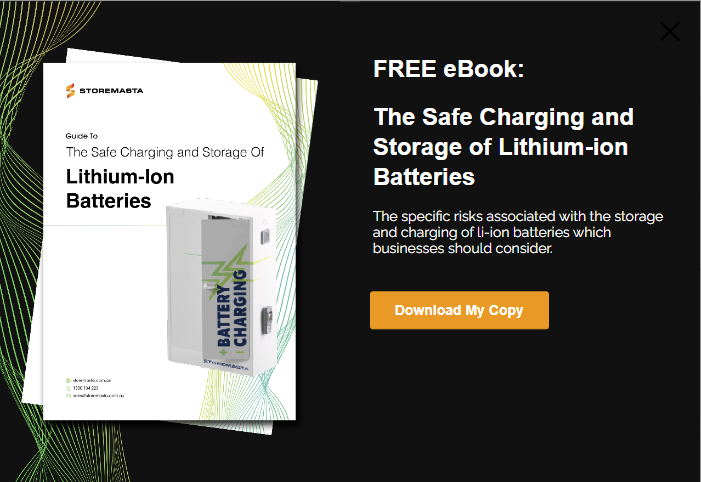Are you aware of the risks associated with storing and charging lithium-ion (Li-ion) batteries? These high-energy, high-power density products are an essential energy source for a vast range of diverse businesses. While Li-ion batteries were developed several decades ago, their ability to provide reliable, long-term performance has made them an increasingly useful energy storage option. With the popularity of Li-ion batteries in workplaces on the rise, it’s also important to note that there have been incidents of fires caused by thermal runaway. Sadly, many of these incidents could have been avoided if the correct handling and storage practices were applied. In this blog, we’re going to explain how the risk of fire and explosion can be reduced by implementing control measures to your stores of Li-ion batteries.
Where Do You Find This Type of Battery?
As we’ve touched on, lithium-ion batteries are a rechargeable battery that’s used across a wide range of applications. If you look around your factory, warehouse or office, you’ll probably find multiple Li-ion batteries that are in everyday use.
You may find lithium-ion batteries in laptops, tablets, mobile phones, solar energy stores, production equipment and power tools. They are becoming increasingly popular due to their suitability for state-of-the-art products such as industrial robots, drones, and electric cars, bikes and marine craft.
How Can Li-Ion Batteries Cause a Fire?
Most of us have heard about the dangers of lithium-ion battery fires. Li-ion batteries have been known to cause fires due to a variety of manufacturing or human errors.
Li-ion battery fires can be caused by:
- Manufacturing faults
- Impact damage
- The age of the battery
- Overcharging
- High temperatures
If the battery is indeed faulty, or it’s sustained damage or been overcharged, the battery cell can become swollen. For example, something as simple as dropping a Li-ion battery can set off a chain reaction of events that may lead to thermal runaway and fire.
 Lithium-ion battery fires may be caused by a battery that’s been overcharged, overheated or misused.
Lithium-ion battery fires may be caused by a battery that’s been overcharged, overheated or misused.
When the battery cell swells, it is filled with an overload of built-up heat and gas. The swelling of the battery cell can quickly lead to a violent release of the pressure — which results in a fire or explosion.
As many workplaces often keep their stores of Li-ion together, there is also the increased risk of cascading thermal runaway. This occurs when one battery cell overheats and overheats any surrounding batteries. As the battery cells continue to overheat and ignite, the fire will continue to grow in intensity. This type of fire is notoriously difficult to put out and can cause devastating destruction to people and property, as well as the surrounding community and environment.
How Does a Battery Cabinet Reduce Risk?
Any organisation that uses Li-ion batteries— whether it’s a drone operator, a manufacturing facility or a remote mining site — should be aware of the risks associated with these batteries and have risk control measures in place to reduce the incident of fire or explosion.
Need to know more about battery safety?
And while many businesses have already implemented a storage solution for their batteries, many are still not aware of the benefits of storing battery supplies in a dedicated lithium-ion safety cabinet.
What Control Measures Does a Battery Cabinet Provide?
As we’ve highlighted earlier in this blog, there are several factors that can increase the likelihood of a swollen battery or lithium-ion battery fire. Purpose-built battery cabinets are designed to reduce these risks and provide safe, secure storage for your batteries.
Features of a Li-ion battery cabinet, such as our latest Storemasta model, may include:
- Double-walled sheet steel construction with a thermal barrier of at least 40 mm between walls
- Sealed gaps around cabinet doors and into the space between walls
- Self-contained spill containment sump to contain leaks
- Self-closing, close fitting doors
- Built-in fan with grill and flex
- RCD Protection
![]() A battery charging and storing cabinet can reduce the risk of thermal runaway and fire.
A battery charging and storing cabinet can reduce the risk of thermal runaway and fire.
We’ll explain how these risk control measures reduce the risk of fire and explosion in more detail below.
Electrically Certified Charging
Designed and constructed right here in Australia, our brand new 240-volt system features a range of control measures to reduce the risk of thermal runaway and lithium-ion battery fires.
Each of our battery cabinets are electrically certified by a qualified electrician, which means that all electrical work meets the highest Australian Standards.
Our battery cabinets are fitted with RCD protection and feature either 18 or 8 power charging outlets.
This design offers ample space for you to recharge or store your Li-ion batteries.
Protection For Your Batteries
Avoiding any type of impact damage is crucial when keeping your batteries in good working order. A battery cabinet that’s constructed from sheet steel will insulate your batteries from any impact damage that may occur in your work area. Everyday occurrences such as dropped tools, moving vehicles and product deliveries can increase the likelihood of impact damage.
The other benefit of a battery cabinet is that it’s a dedicated storage space for your batteries. With batteries being such a common sight in factories, warehouses, offices and remote sites, staff can become complacent and adopt poor handling and storage practices. However, when you’re dealing with Li-ion batteries, you don’t want staff leaving batteries just lying around. Using a battery cabinet can help staff improve safety and efficiency when handling and storing their Li-ion batteries. A battery cabinet can also help you reduce unnecessary expenditure, as there’s less chance for the batteries being misplaced, lost or stolen.
Temperature Control
Temperature control is a critical factor when considering your battery storage requirements. As extreme temperatures can adversely affect the battery, it’s important to keep your batteries at a comfortable room temperature. Particularly in hot climates such as Australia, careful consideration should be given to the environment in which the Li-ion batteries are stored.
Our battery cabinet is equipped with several temperature control measures. These include a sheet steel construction, with a thermic air barrier between the walls. This air barrier creates an insulating effect which allows the cabinet to remain at a stable temperature.
Our battery cabinet is also equipped with a 150 mm fan, complete with grill and flex that can produce 67 cubic metres of air per hour. By increasing the air flow in the cabinet, you’re providing a natural means of ventilation and temperature control.
Heat and Fire Protection
If a fire breaks out in your workplace, it’s important that your batteries are shielded from the flames and heat radiation. Safety cabinets are constructed to protect the contents of the cabinet due to the sturdy construction and thermic barrier. The cabinet is also constructed with sealed gaps around doors and into the space between walls. Self-closing, close fitting doors are another risk control features which prevents heat penetrating the cabinet in the event of a workplace fire.
While the cabinet will eventually succumb to the workplace fire if it isn’t able to be extinguished, the control measures allow for a small window of time for fire equipment to be utilised or emergency services to be called.
Spill Containment
Battery cabinets, just like other Dangerous Goods cabinets, are equipped with a spill containment system. This system directs any battery fluid leaks into a sump that’s located at the bottom of the cabinet. This allows for the prompt clean up of any leaks, as well as containing chemical spills in your workplace.
Where are You Keeping Your Lithium-Ion Batteries?
Battery cabinets provide a convenient, safe and efficient storage and charging solution for businesses who rely on Li-ion batteries to power their operations. Our cabinets have been created to specifically address the needs of our customers and come equipped with a 5-year warranty. If you’re concerned about your stores of batteries — or any hazardous chemicals or Dangerous Goods — we strongly suggest conducting a risk assessment to determine your storage needs.
If you’d like some simple advice on how to reduce the risk of Li-ion batteries in your workplace, why not access your copy of our free eBook today?

Living life by the 4 C’s of marketing – communication, coffee, compliance… and more coffee – Leisa Andersen is Storemasta’s Content Marketing Manager. When she’s not writing, you’ll find her enjoying all the good things in life, including shopping, travel and gluten free donuts.
